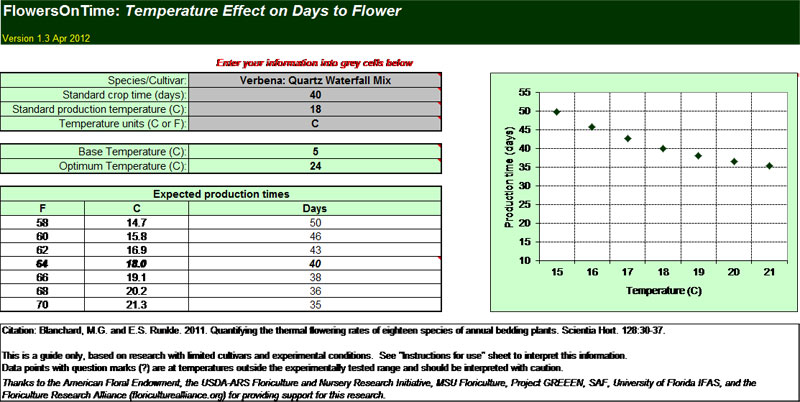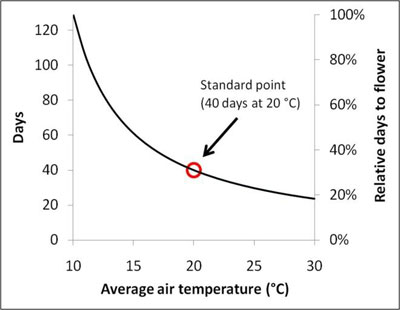 |
October 2012
|
October 2012 // Volume 50 // Number 5 // Tools of the Trade // v50-5tt3
FlowersOnTime: A Computer Decision-Support Tool for Floriculture Crop Producers
Abstract
A computer decision-support tool was developed as an Extension outcome of the Floriculture Research Alliance to help commercial plant growers and educators estimate the effect of changing average air temperature on production time of over 60 species and cultivars of herbaceous ornamental crop plants. Cropping time predictions are based on research data from 16 sources. This information can help growers determine appropriate greenhouse temperature settings so that their plants are in flower on time to meet pre-determined market dates. The target audiences are growers, Extension professionals, and crop consultants.
Introduction
Flowering plants (including bedding plants, herbaceous perennials, potted plants, and cut flowers) are generally required by the retailer to be in flower when delivered by a floriculture grower. If plants are not yet blooming, or are overly mature with senescing flowers, the crop can either be rejected by the buyer, or the grower may receive a lower price.
Time to flower responds strongly to average air temperature (Summerfield, Ellis, Craufurd, Aiming, Roberts, & Wheeler, 1997). Greenhouse growers therefore often adjust temperature through greenhouse heating and cooling so that plants flower when desired. With low profit margins, Extension educators and crop consultants increasingly need to assist grower clients who are considering a reduction in greenhouse air temperature in an attempt to save on heating fuel cost, but this results in a delay in flowering. Growers also require trouble-shooting help if the crop is developing too fast or slow under current conditions to achieve a target flowering date. Polling of 61 floriculture grower and allied horticulture supplier stakeholders in the Floriculture Research Alliance (floriculturealliance.org) in 2008 identified prediction of light and temperature responses on flowering as one of the top four research and Extension areas.
Flowering response to temperature is quantified using "thermal time" models, which are also called "degree-day models." Key concepts for these models are that (a) there is a "base temperature" below which plants do not develop towards flowering, (b) crop time decreases as the temperature increases above the base temperature, and (c) there is an "optimum temperature" above which crop time is not reduced (or may actually be delayed) as temperature increases (Arnold, 1959; Roberts & Summerfield, 1987).
For Extension use, these research models and data on plant temperature response should be packaged as decision tools to deliver these results for crop decision-making. Agriculture producers already use computerized programs and spreadsheets to assist them in making informed, science-based decisions in other commodities and decision areas, for example, production of Easter lily (Fisher, Heins, Ehler, & Lieth, 1997), field crops (Jame & Cutforth, 1996), and cattle (DeVuyst, Epplin, Peel, Horn, & Lalman, 2010), or management of environmental impacts such as manure (Harrison, Kanade, & Toney, 2004).
Overview of the Computer Decision-Support Tool
A tool was developed to predict the effect of changing the air temperature on flowering time of over 60 herbaceous ornamental species and cultivars. Created in Microsoft Excel, the tool is based on 16 published research studies in which scientists grew crop plants at a limited range of temperatures and recorded flowering time. Researchers then fit predictive curves (thermal time models) to the data, using either a linear degree-day or Landsberg function (Arnold, 1959; Roberts & Summerfield, 1987). In instances where authors had developed thermal time models, these functions were used in the tool. Where authors reported flowering time and temperature data only, we statistically fit a degree-day or Landsberg function to the data using linear or nonlinear regression, respectively.
For an Extension audience, these models function in the background, and the user only needs to enter readily available information in order to receive customized results. The user first selects a crop in the drop-down list of species and cultivars. Next, the user must specify the finish crop time at a particular temperature, based on past experience, their growing conditions, their starting plant material size (for example, a 128-cell plug), and their finished crop specifications (for example, a 606 flat with at least six open flowers). This "standard crop time" and "standard temperature" entered by the user into the tool provides a single known data point (crop time) under one set of conditions.
Figure 1.
The FlowersOnTime Decision-Support Tool Interface

The concept of a "standard crop time" and "standard production temperature" are central to this tool, linking a research model to commercial conditions. A given research project that generates a thermal time model is often performed under one specific combination of starting young plant material, light conditions, and definition of what constitutes a finished, flowering plant. Those conditions are almost certain to vary in a commercial location. For example, the research project may have been undertaken in a controlled growth chamber with constant artificial light and temperature, which differs from the varying light and temperature conditions in a greenhouse.
In research trials, it is simply not feasible to include factorial effects of all possible combinations of conditions such as young plant material size and light conditions, in addition to temperature. Therefore, the model uses the research data to quantify the base temperature and relative temperature response as temperature increases ("Relative days to flower" in Figure 2). This curve is calibrated to commercial conditions by scaling the thermal time curve to pass through the known data point of a standard crop time and temperature provided by the user of the tool (converting the curve into "Days" in Figure 2).
Figure 2.
A Thermal Time Model for Petunia 'Classic Wave Purple' with a Linear Degree Day Model and a Base Temperature of 42 °F (5.5 °C) to Produce a Relative Temperature Response Curve

* Based on Research by Blanchard & Runkle (2011)
**This relative curve is scaled to a known "standard" data point provided by a grower, in this case 40 days from transplant to flower at 68 °F (20 °C).
The thermal time model then predicts how the standard crop time will change by increasing or decreasing air temperature by 6 °F (3.3 °C) at 2 °F (1.1 °C) intervals, assuming all other conditions such as light level remain the same (Figure 1).
Some of the factors that would reduce the accuracy of the model predictions include the following.
- The cultivar of interest differs from the cultivars tested. For most species, only one cultivar has been tested.
- The temperature entered by the user is not a typical production temperature. Errors are more likely at extreme temperatures near the base temperature or above the optimum temperature.
- The temperature entered by the user is outside the range of those tested experimentally. Temperatures not tested experimentally are denoted with question marks (?) to emphasize uncertainty.
- By growing a crop warmer or cooler, the new cropping period could include conditions, such as day length, that vary in ways other than just temperature.
The spreadsheet includes an instructions page on how to use the tool, as well as a description of model limitations and assumptions. The tool also includes a literature database that cites the researchers and original source of the information along with a hotlink to the published abstract. We plan to add crops to this tool as other research-based information becomes available.
Conclusions
FlowersOnTime converts complex quantitative research models and data into a user-friendly spreadsheet for use by Extension educators and growers. The tool can be downloaded free at http://floriculturealliance.org under the Grower Resources Grower Tools tab. For the 6-month period ending Feb 2012, there were 126 unique visitor downloads comprised of growers (61%), academics and Extension educators (26%), and horticulture suppliers or consultants (23%). The concept of a "standard crop time" in this tool allows research models to be calibrated to real-world production conditions.
References
Arnold, C. Y. (1959). The determination and significance of the base temperature in a linear heat unit system. Proceedings of the American Society for Horticultural Science. 74:430-445.
Blanchard, M. G., & Runkle, E.S. (2011). Quantifying the thermal flowering rates of eighteen species of annual bedding plants. Scientia Horticulturae. 128:30-37.
DeVuyst, E. A., Epplin, F., Peel, D., Horn, G., & Lalman, D.L . (2010). Wheat stocker decision tools. Journal of Extension [On-line] 48(3) Article 3TOT8. Available at: https://www.joe.org/joe/2010june/tt8.php
Fisher, P. R., Heins, R. D., Ehler, N., & Lieth, J. H. (1997). A decision-support system for real-time management of Easter lily (Lilium longiflorum Thunb.) scheduling and height - I. System description. Agricultural Systems. 54(1):23-37.
Harrison, J. D., Kanade, S. S., & Toney, A. H. (2004). Agriculture environmental management information system: An online decision support tool. Journal of Extension [On-line] 42(1) Article 1TOT4. Available at: https://www.joe.org/joe/2004february/tt4.php
Jame, Y. W., & Cutforth, H. W. (1996). Crop growth models for decision support systems. Canadian Journal of Plant Science. 76(1):9-19.
Landsberg, J. J. (1977). Some useful equations for biological studies. Experimental Agriculture. 13(3):273-286
Roberts, E. H., & Summerfield, R. J. (1987). Measurement and prediction of flowering in annual crops. In: Atherton, J.G., Editor, Manipulation of flowering. Kent, UK: Butterworths, pp. 17-50.
Summerfield, R. J., Ellis, R. H., Craufurd, P. Q., Aiming, Q., Roberts, E. H., & Wheeler, T. R. (1997). Environmental and genetic regulation of flowering of tropical annual crops. Euphytica 96(1):83-91.




